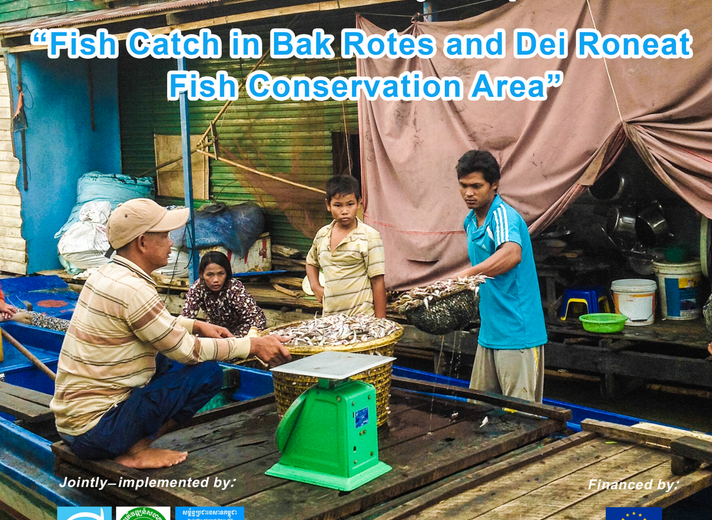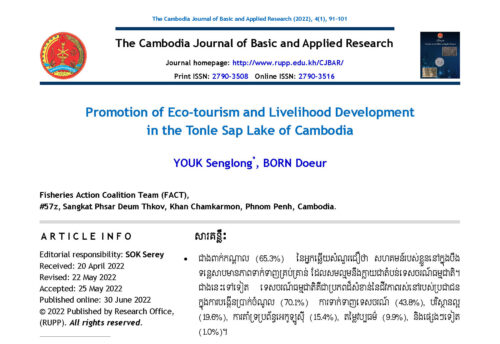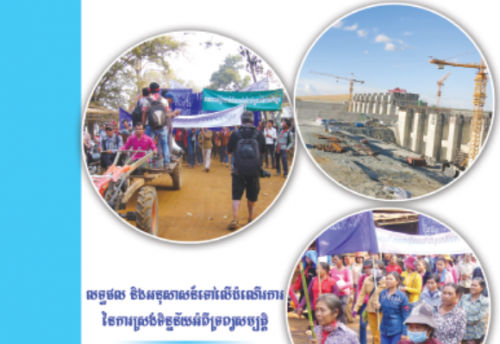
Baseline Purpose and Methodology
The Fisheries Action Coalition Team (FACT) has been granted funding for three years to implement the project on “Strengthening Capacity of Fisher’ Network and NGO Coalition towards Fisheries Resources Sustainability and Ownership in Mekong and Tonle Sap Regions (EU-SFiN-NGO). The major specific objective of the project is to strengthen the grassroots Cambodian fisher and communities in Cambodia’s Mekong and Tonle Sap and empower them to protect and conserve fisheries resources in sustainable manner. The EU-SFiN-NGO project’s staffs have working closely with the NGO partners and CCF in order to achieve the following expected results:
- Networking between NGO partners working on fisheries resources management in Cambodia’s Mekong and Tonle Sap is established and well strengthened.
- Networking between grassroots fisher and communities in Cambodia’s Mekong and Tonle Sap is established, strengthened and empowered to advocate for better fisheries resources management via policy dialogues and advocacy campaigns.
- Fisheries resources in the target areas where the project implemented will be increased.
- The result of project baseline study and project evaluation will be produced and disseminated widely among donors, NGO partners and grassroots communities.
- Experience and lessons learnt from the project implementation will be replicated via learning and replication workshop(s).
The baseline study has been commissioned by FACT with the purpose to (i) investigate the livelihood conditions and livelihood options of the local fisher to generate additional family incomes; (ii) understand the knowledge and rights of the local fisher to fisheries resources management and conservation; (iii) explore the fish catch of local fisher and situations nearby the Bak Rotes and Dei Roneat; and (iv) examine the public (right holder and duty bearer) participation in managing and conserving the local fisheries resources.
The baseline study applies both quantitative and qualitative approach for data collection and analysis. Both quantitative and qualitative data collection was conducted between the 1st – 6th and 19th – 24th August 2016. Quantitative data collection involved questionnaire survey with 124 residents in 5 villages out of the two FCAs, namely Bak Rotes and Dei Roneat. Qualitative data collection consisted of key informant interview (KII) with five village chiefs, and some of CFis/CBOs leaders, and focus group discussion (FGD) with four groups from each FCAs. The secondary data collection was undertaken from reviewing the existing project documents and other existing research reports of FACT. Descriptive and some inferential statistic of SPSS were applied for data analysis.
Key Findings and Results
Livelihood Option and Condition
- Villager in Bak Rotes (60.2%) had strong depend on the rice cultivation as their primary occupation and sources of income followed by fishing (23%) while a large proportion of villagers in Dei Roneat (95.6%) were fishers and extremely reliance on fishery resource for income generation activity.
- Fish farming had been considered as a great supplementary job of villagers, particularly in Dei Roneat stretch. Almost of all villagers in Dei Roneat (64.7%) had a supplementary occupation as the fish raising/farming while over half of villagers (58.8%) in Bak Rotes had raised livestock, i.e., cattle, chicken and pigs for their additional livelihood development.
- As for types of expenditure, the villagers in Bak Rotes spent majority of income for daily food consumption followed by social events. Similarly, villagers in Dei Roneat spent the vast majority for daily food consumption followed by daily transportation.
- Overall, villager earned around US$ 1.5 and spent US$ 1.3 per capita per day. Villagers in Bak Rotes were able to earn approximately US$ 1.6 per capita per day and spent US$ 1.3 per capita per day while in Dei Roneat obtained US$ 1.3 and the amount of daily expenditure US$ 1.4.
- Nearly two-third of villagers in Bak Rotes and only few of villagers in Dei Roneat had loaned out financial support from microfinance institution. More than half of villagers in Dei Roneat and some of villagers in Bak Rotes had borrowed money from middlemen or their neighboring.
- Over half of villagers endured live under the poverty line. More than half of villagers in Dei Roneat remained live below the poverty line while half of villagers in Bak Rotes had better off.
General Knowledge and Understanding the Right on Fishery Resource
- Knowledge of villagers were considerably high in terms of understanding about the illegal fishing gears (legal and illegal equipment), access to fishing space, cancellation of commercial fishing lots, involvement in fisheries resources management and conservation albeit limited in practical terms.
- Nonetheless, the knowledge were around the illegal fishing gears, access to fishing grounds, involvement and reporting of the illegal cases to local authorities but lack of understanding about reporting of illegal cases and pathways to sustain the fisheries resources.
- Apropos of CFi/CBO management, villagers’ knowledge and understanding vis-à-vis how to prepare activity and budget planning, requesting, reporting, communicating and advocating remained low and need more strengthen through training and on job training.
- Villagers had fairly understood about the right to participate, manage and conserve the fishery resource but they had difficulty participating in those activities because they were afraid of the threats from the illegal fishing perpetrators.
- Our survey found that, some of the villagers particularly in Dei Roneat were also involved in the illegal fishing activities, but they less engaged than those who came from outside the areas. If respondents were actively engaged in the reporting of the illegal fishing activities to the authorities, their livelihoods would be affected or get the fear from illegal fishers.
Fish Catch Situation and Quantity
- Villagers behaved differently in term of accessed to fish. Villagers in Dei Roneat who strongly depend on fishery resource were regular access to fish than those in Bak Rotes had less activity because of dramatically decline of fisheries resources.
- A large proportion of villager preferred using gill net, hook long line, cast net, Loer and fish trap, respectively.
- Villagers in Bak Rotes used to access fishing in the community fishing area and near fish conservation area while majority of them exploited the fisheries resources outside the community fishing grounds.
- Apropos of fish catch, the villager were generally collect fish around 9.2 kilograms per day per household. Villagers in Bak Rotes were likely to collect fish less than those in Dei Roneat fish conservation area. The villagers in Bak Rotes collected on average 3.3 kilograms of fish per day per household, while those in Dei Roneat collected on average 15.1 kilograms of fish per day per household.
- On average, villagers who were members could collect fish around 3.2 kg per day while non-members of CFi/CBO could collect 4.5 kg per day.
- Villagers consumed fish about 1.1 kilograms per household per day. The villagers who lived in Dei Roneat consumed fish on average 1.2 kilogram per household per day while those who lived in Bak Rotes consumed slightly less than 1 kg per household per day.
- Generally, the villagers sold approximately 8.1 kilogram of fish per day per household. Fish production was sold higher in the Dei Roneat (13.9 per day per household) than in Bak Rotes (2.3 per day per household).
- With regards to income from the fisheries resources, villagers gained an average income of approximately US$ 3 per day per household. Comparatively, villagers in Bak Rotes earned around US$ 1.8 per day per household while Dei Roneat obtained US$ 4.2 per day per household.
Public Participation
- The public participation was likely stumpy since villagers remained concerned with livelihood condition. Almost half of the villagers had never participated in any social activities even they lived close to the place of event.
- Nearly half of the villagers in Dei Roneat had been involved in meeting in their village to discuss on general issues faced while less than half of villagers in Bak Rotes had participated in meeting in their village.
- Regarding the involvement in commune investment plan (CIP), the villagers in Bak Rotes (38%) was more involved in the activity than those in Dei Roneat (9.1%).
- Majority of them had joint as participant to take part in the social activities, while few of them had been involved as organizing committee, decision makers and observers in the social participation process.
- Villagers willing to participate because of improving knowledge and capacity, part of community development work, increasing of fisheries resources, accessing to community fishing ground and information.
- Some of villagers have never ever participated in any community development activities because there was no invitation, conflict of timing/time constrain, lack of information and knowledge, livelihood condition, not a membership of CFi/CBO and not get any benefit from the participation.
Recommendation
According to the result from baseline study, the survey team would like to raise some suggestion and recommendation as follow:
- Livelihood option: livelihood option of fishers is very crucial in order to make a contribution to income generation. However, sufficient livelihood skill of the fishers remained a low because they were not provided training and support from outside.
- Capacity building: Capacity building and on job training should be frequently and regularly provide to CFi leader and committees with the specific areas such as funding raising (Proposal development), planning, budgeting, monitoring and reporting.
- Funding support: FACT or any organization should provide the financial support in order to conservation the mother fish in the fish conservation area because CFi committee are unable to seek the financial support in the fish conservation activities themselves.
- Fish catch monitoring plan: Daily fish catch monitoring tools should be developed in order to tracking the change of fisheries resources with monthly basic with specific sample size.
- Fish catch evaluation plan: by annually, fish catch evaluation should be developed in order to assess the change of fisheries resources with a large sample size.

















Leave a Reply